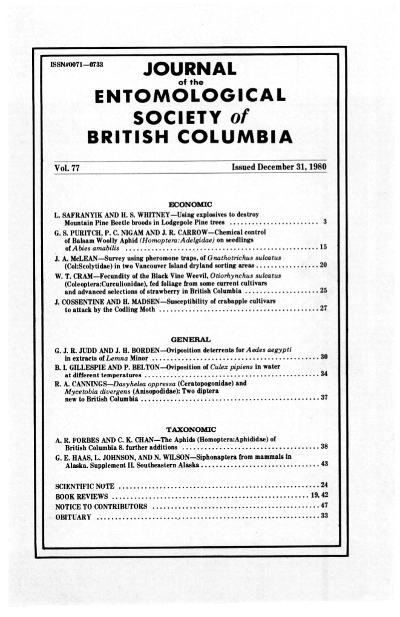Fecundity of the black vine weevil, <i>Otiorhynchus sulcatus</i> (Coleoptera: Curculionidae), fed foliage from some current cultivars and advanced selections of strawberry in British Columbia
Keywords:
black vine weevil, <i>Otiorhynchus sulcatus</i>, Coleoptera, Curculionidae, strawberryAbstract
Adults of the black vine weevil, <i>Otiorhynchus sulcatus</i> (F.), kept individually in plastic vials in the laboratory were fed foliage picked from strawberry cultivars or selections in one field of the British Columbia strawberry breeding program at Abbotsford. The source of foliage had no significant influence of preoviposition period, weight gain, or amount of foliage consumed. However, there were significant differences in the number of eggs laid during a ten-week period and in the number of larvae that hatched. The fewest eggs were laid and larvae hatched when weevils fed on the new cultivar Tyee and the selection BC 73-9-79. The other foliage sources in order of increasing numbers of eggs were BC 70-22-82, Totem, BC 69-5-34, Shuksan, and BC 70-20R-15.References
Cram, W.T. 1970. Unacceptability of cultivars of highbush blueberry by adult black vine weevils (Coleoptera: Curculionidae). J. Entomol. Soc. Brit. Columbia 67:3-6.
Cram, W.T. and W.D. Pearson. 1965. Fecundity of the black vine weevil, Brachyrhinus sulcatus (F.), fed on foliage of blueberry, cranberry and weeds from peat bogs. Proc. Entomol. Soc. Brit. Columbia 62:25-27.
Daubeny, H.A. 1980. Tyee strawberry. Can. J. Plant Sci. 60:743-746.
Downloads
Published
Issue
Section
License
Authors who publish with the Journal of the Entomological Society of British Columbia agree to the following terms:
-Authors retain copyright and grant the journal right of first publication with the work simultaneously licensed under a Creative Commons Attribution License that allows others to share the work with an acknowledgement of the work's authorship and initial publication in this journal.
-Authors are able to enter into separate, additional contractual arrangements for the non-exclusive distribution of the journal's published version of the work (e.g., post it to an institutional repository or publish it in a book), with an acknowledgement of its initial publication in this journal.
-Authors are permitted and encouraged to post their work online (e.g., in institutional repositories or on their website) prior to and during the submission process, as it can lead to productive exchanges, as well as earlier and greater citation of published work (See The Effect of Open Access).


